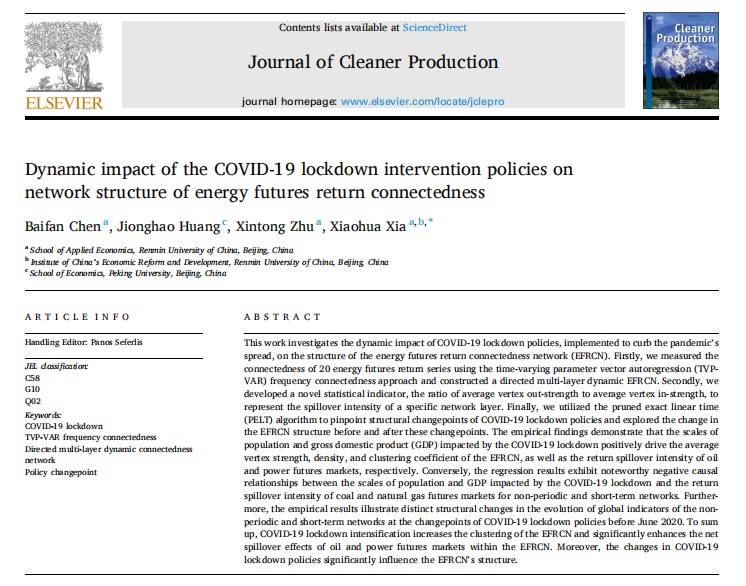Dr. Xiaohua Xia recently had a paper published in the Journal of Cleaner Production. The paper titled‘Dynamic impact of the COVID-19 lockdown intervention policies on network structure of energy futures return connectedness’, was coauthored with Baifan Chen and Xintong Zhu from Renmin University of China, Jionghao Huang from Peking University.

Abstract
This work investigates the dynamic impact of COVID-19 lockdown policies, implemented to curb the pandemic’s spread, on the structure of the energy futures return connectedness network (EFRCN). Firstly, we measured the connectedness of 20 energy futures return series using the time-varying parameter vector autoregression (TVPVAR) frequency connectedness approach and constructed a directed multi-layer dynamic EFRCN. Secondly, we developed a novel statistical indicator, the ratio of average vertex out-strength to average vertex in-strength, to represent the spillover intensity of a specific network layer. Finally, we utilized the pruned exact linear time (PELT) algorithm to pinpoint structural changepoints of COVID-19 lockdown policies and explored the change in the EFRCN structure before and after these changepoints. The empirical findings demonstrate that the scales of population and gross domestic product (GDP) impacted by the COVID-19 lockdown positively drive the average vertex strength, density, and clustering coefficient of the EFRCN, as well as the return spillover intensity of oil and power futures markets, respectively. Conversely, the regression results exhibit noteworthy negative causal relationships between the scales of population and GDP impacted by the COVID-19 lockdown and the return spillover intensity of coal and natural gas futures markets for non-periodic and short-term networks. Furthermore, the empirical results illustrate distinct structural changes in the evolution of global indicators of the nonperiodic and short-term networks at the changepoints of COVID-19 lockdown policies before June 2020. To sum up, COVID-19 lockdown intensification increases the clustering of the EFRCN and significantly enhances the net spillover effects of oil and power futures markets within the EFRCN. Moreover, the changes in COVID-19 lockdown policies significantly influence the EFRCN’s structure.
Other information
Publication Date:2023
Journal: Journal of Cleaner Production
DOI:https://doi.org/10.1016/j.jclepro.2023.139802
Read the paper here.